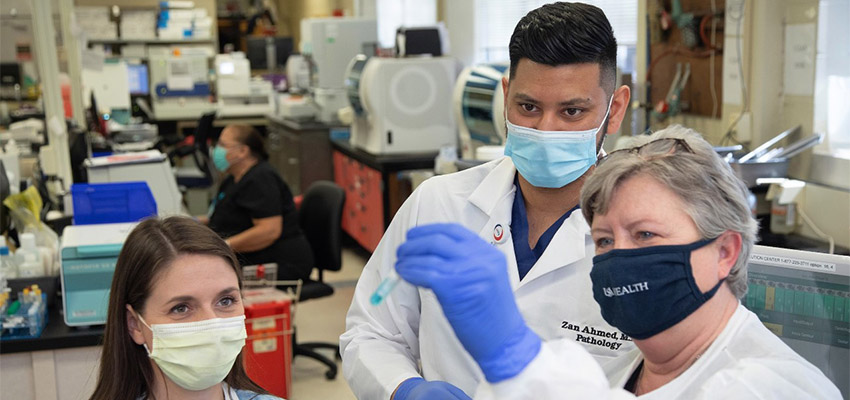Residents dig into safety initiatives
Posted on October 25, 2021 by Carol McPhail

Near the blood bank at USA Health University Hospital, Zan Ahmed, M.D., points to a bar graph on his laptop. “We want to ensure that the blood we’re dispensing is of best practice,” he says.
Ahmed, chief pathology resident, has gathered data on the various blood products dispensed at the hospital – red blood cells, platelets, cryoprecipitate, and fresh frozen and liquid plasma. The graph shows how much of each product is requested by physicians for use in the hospital and how much of it is returned to the lab unused.
“The shelf life (on some components) is very limited. Once frozen plasma is thawed, it can only be used for 24 hours,” Ahmed said. “We are investigating to see how we can improve the system and transfusion culture.”
Ahmed is among several physicians-in-training at USA Health who have launched quality projects with a goal of making the health system a highly reliable organization. Their projects are part of the overall quality and safety initiative USA Health launched earlier this year.
“To drive meaningful improvement, residents must be involved,” said Kristen Noles, D.N.P., R.N., C.N.L., L.S.S.G.B., health system performance manager for USA Health. “Our residents function in our healthcare system performing heroics to do right for our patients every day.”
Noles said it’s imperative to create structures that allow for frontline staff to voice the realities of practice and ask questions. “Interprofessional collaboration working to improve the system will result in improved quality outcomes for all patients served,” she said.
In Ahmed’s case, improving quality at University Hospital means following best practices and using data to make the most efficient use of a precious donated resource. He recently presented his findings to his pathology colleagues and to the House Staff Quality Safety Council, on which he serves as vice-chair.
One of his ideas is to optimize the trigger points that prompt a physician to order blood for a patient. Another is to move to a modern “single transfusion” approach – dispensing single units of blood upon request rather than the current practice of automatically dispensing two units at a time. Such changes would be accompanied by continued data analysis and education for everyone involved in the care process.
“Our aim is to go in and understand this unit going out, questioning whether it is truly necessary and using modern literature with evidence-based practices to refine the patient blood management system,” Ahmed said.
Third-year internal medicine resident Sana Ozair, M.D., is working on a different quality improvement project to reduce the incidence of CLABSI, or central line-associated bloodstream infections. A central line is a type of catheter placed in a large vein that helps in monitoring hemodynamic parameters as well as allowing safe administration of IV medications/fluids that cannot be given peripherally for resuscitation.
“Central lines are vital in the care of critically ill patients,” she said. “But a bloodstream infection related to central lines can result in increased mortality and prolonged hospital stays.”
Ozair is taking a multidisciplinary approach to reducing the incidence of CLABSI at University Hospital. She led the development of an algorithm for determining when to test patients for a central line-associated infection, such as upon admission to the hospital.
Ozair also took part in creating a standardized workflow – a power plan – to guide providers in the best practices for ordering blood cultures in patients. The next step will be to establish a standardized note template in electronic medical records to document the placement and management of central lines so that all healthcare providers have access to the information.
“We’ve already seen a decrease in the number of CLABSIs,” she said. “It’s predicted that the rate will continue to decrease moving forward.”
For information on how to get involved with the House Staff Quality Safety Council, contact Danielle Haynes at daniellehaynes@health.southalabama.edu.


